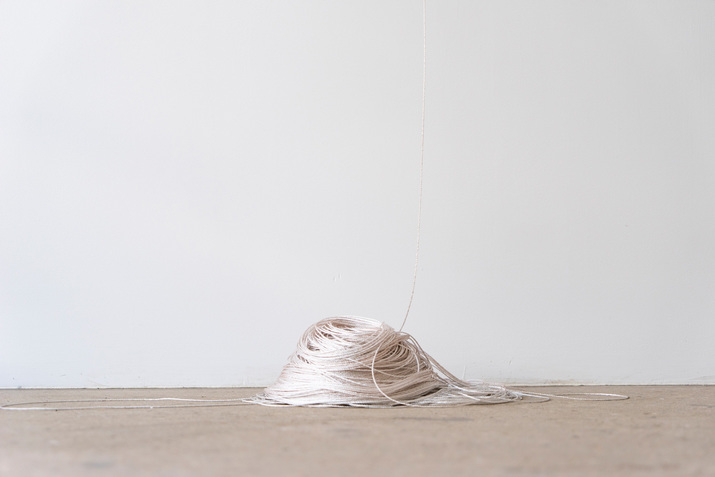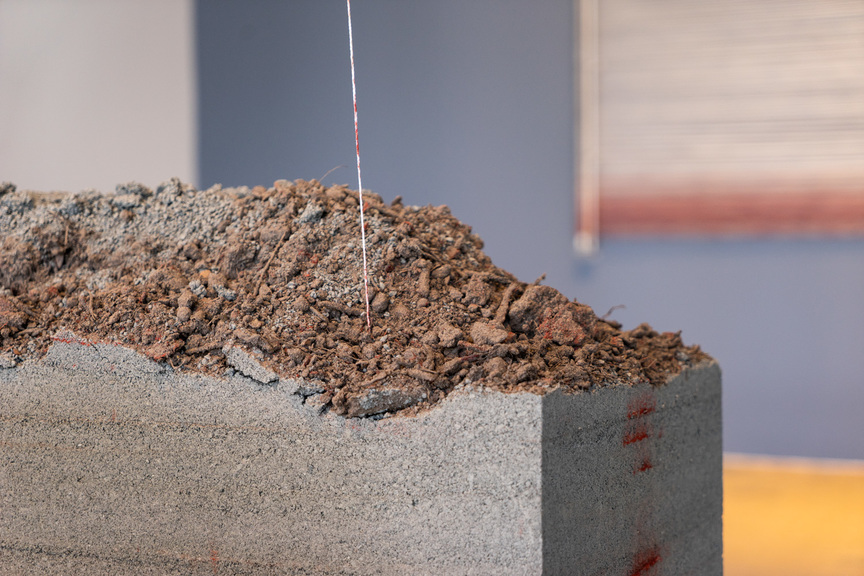-
From Current Issue
-
- Editor’s Letter Fire in the Heart
- Reviews I Gusti Ayu Kadek Murniasih
- Reviews 11th Seoul Mediacity Biennale: “One Escape at a Time”
- Dispatch Networked China
- One on One Monira Al Qadiri on Yukio Mishima
- Essays The rise of independent art spaces in pandemic-era Shanghai
- Features Tuan Andrew Nguyen
- Table of Contents
- Web Exclusives
- Archive
- Subscribe

R
E
V N
E
X
T
Installation view of ROBERT ANDREW’s Presence, 2019, soil, ocher, oxides, string, aluminum, and electro-mechanicals, dimensions variable, at IMA Belltower, Judith Wright Centre of Contemporary Arts, Brisbane, 2019. All photos by Louis Lim; courtesy the artist and the Institute of Modern Art, Brisbane.
In the middle of Robert Andrew’s recent display, Presence (2019), sits a large block of gray soil, crusher dust, oxide, and ocher. A long string lies within this multilayered form, coiled among the earth and natural pigments. Through a system of automated pulleys, the string is hoisted from the compacted soil, thus crumbling the block from within. It travels upwards, along the ceiling, and then weaves back and forth across two poles fixed to the wall, somewhat like the strings of a loom. Once it has zig-zagged through this frame, it moves back across the ceiling and finally collects on the floor, in a corner of the gallery.
As one element of Andrew’s work crumbles, another is revealed. The string embedded in the soil absorbs some of the red oxides; over the course of the show, as they repeatedly emerge from the block and work their way to the wall, the lines of string become streaked with rusty tones. Finally, the central sculpture is carved, or carves itself, into a misshapen mass of soil.
Andrew had orchestrated this process to run for the full nine weeks of the show, ultimately relinquishing control once it was set in motion and leaving the steady drive of the machine to determine the final work. The string measures over three kilometers long and the mechanism is set at just the right speed so the slab will not disappear either too quickly as to be unsatisfying or too slowly to be imperceptible. This entropic collapse was mesmerising to watch, and at once frustrating and pleasing: the pity in seeing something destroyed only matched by the satisfaction of tearing it down, like kicking a sandcastle.
Andrew’s practice appeals increasingly to this visceral response, incited by the materials of his work. The artist is a descendant of the Yawuru people; his mother’s country encompasses Rubibi (Broome) and its surrounds in the Kimberley Region of Western Australia. In an earlier work, A Connective Reveal — Language (2019), activated at The National this year, he had programmed a machine to spray small amounts of water onto an ocher-covered surface, slowly spelling out, by virtue of a chemical reaction, an Indigenous word belonging to the language group of the exhibition’s location. Upon contact with water, the chalky, white pigment turned to copper-red, as if forgotten language was seeping through the gallery walls. In Presence, his focus is not so much language as it is Country. The landscape of the Western Kimberly is rippled with deep ochers; its shores lined with strata of red rock, much like the layered block in his show.
Many have compared Andrew’s practice to an archaeological dig; his kinetic sculptures serving to unearth a word or concept hidden within natural materials. Yet, the work makes no distinction between artifact and earth, tool and treasure. His is a futile archeology in which the object crumbles under its own discovery or rather is discovered only through its destruction. In Presence, the moving string cuts away at the block but also holds together the final shape, paradoxically acting as both the tool and the final object of this excavation.
The success of Presence is not in what the mechanism uncovers but its enactment of ongoing discovery. The gradations of rock and oxide measure the accumulation of time, quite literally, with each centimeter of broken soil translating to roughly an hour of labor. These layers also suggest the longer stretch of geological time. But the core of the block left standing at the end of the show’s run will not be an artifact released from the past, and here the archaeological metaphor falls short. Rather, Andrew’s work illustrates how the land is simultaneously old and part of daily life in the present. Slowly, the winding string pulls through the stratified soil, much like time might travel through Country but is always tethered to it.
Robert Andrew’s “Presence” is on view at the IMA Belltower, Judith Wright Centre of Contemporary Arts, Brisbane, until October 26, 2019.
To read more of ArtAsiaPacific’s articles, visit our Digital Library.



















